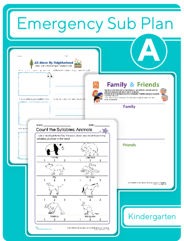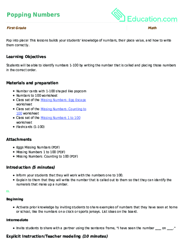- Worksheets
- Games
- Lesson Plans
- Workbooks
- Exercises
- Science Projects
- Skills Progression
- More
Search Lesson Plans
2,618 filtered results
2,618 filtered results
Sort by

Sub Plans for Fourth Grade
Lesson Plan
Sub Plans for Fourth Grade
Planning for a substitute teacher in the classroom has never been easier than with this week-long sub packet for fourth grade! Your substitute can supercharge learning with lessons that will educate and inspire your students!
4th grade
Reading & Writing
Lesson Plan

The Solar System: Learning about Planets
Lesson Plan
The Solar System: Learning about Planets
Use this lesson to have your students research about a planet of their choice and present it to the class! This lesson will also give the creative students of your class an opportunity to make their own planets!
3rd grade
Science
Lesson Plan

Fragment or Sentence?
Lesson Plan
Fragment or Sentence?
This lesson includes a bunch of hands-on activities to get little writers excited about complete sentences. After learning about subjects and predicates, students will tackle the challenge of writing their own sentences and fragments.
4th grade
Reading & Writing
Lesson Plan

Close Reading: Introduction
Lesson Plan
Close Reading: Introduction
Help your students absorb the details of a text and make inferences about what they read with the strategy of close reading. By reading closely, students will become better able to understand complex themes and nuances in a text.
3rd grade
Reading & Writing
Lesson Plan

Kindergarten Daily Sub Plan Day 1
Lesson Plan
Kindergarten Daily Sub Plan Day 1
Planning for a substitute in the classroom has never been easier than with this daily kindergarten sub plan! Your substitute can keep your students learning in your absence by using these lessons, worksheets, and activities.
Kindergarten
Reading & Writing
Lesson Plan

Compare and Contrast Experiences: Reading and Listening to Poetry
Lesson Plan
Compare and Contrast Experiences: Reading and Listening to Poetry
In this lesson, students read and then listen to the audio version of a classic poem, Auld Lang Syne. They'll use a graphic organizer to compare and contrast their experience of reading the poem to listening to musical version of the poem.
6th grade
Reading & Writing
Lesson Plan

Multiplying Whole Numbers and Fractions: Illustrated!
Lesson Plan
Multiplying Whole Numbers and Fractions: Illustrated!
Give your students insight into what’s going on when you multiply a whole number and a fraction! Use this lesson plan to teach your students to illustrate products of whole numbers and fractions using number lines.
5th grade
Math
Lesson Plan

Using Word Parts to Determine the Meaning of Words
Lesson Plan
Using Word Parts to Determine the Meaning of Words
Give your readers the tools to decipher the meaning of Greek and Latin based words. In this lesson they review the meaning of commonly used prefixes, suffixes and roots and then practice constructing and deciphering words.
5th grade
Reading & Writing
Lesson Plan

Sequencing the Order of Events
Lesson Plan
Sequencing the Order of Events
The sequence of events help readers recount the most important parts of the story in order. Use this lesson with your students to read fables and a classic picture book as you practice recounting the sequence of events.
3rd grade
Reading & Writing
Lesson Plan
Where Am I?, Understanding Plot Lesson Part IIII
Lesson Plan
Where Am I?, Understanding Plot Lesson Part IIII
Sometimes authors choose to describe their setting for readers to imagine, but don't actually tell them where the story is set! In this lesson, students will learn to deduce settings from context.
4th grade
Reading & Writing
Lesson Plan














